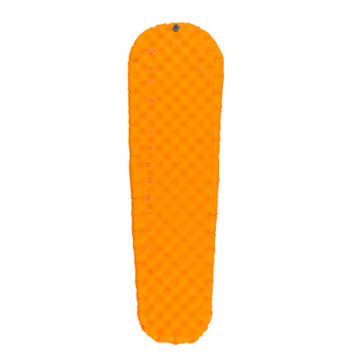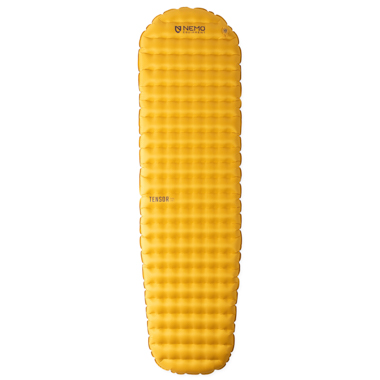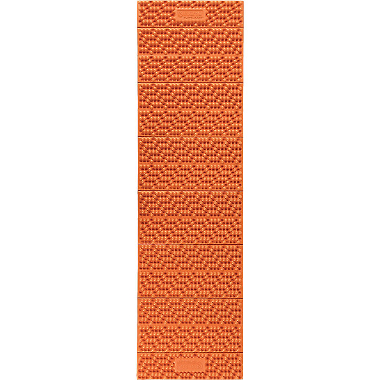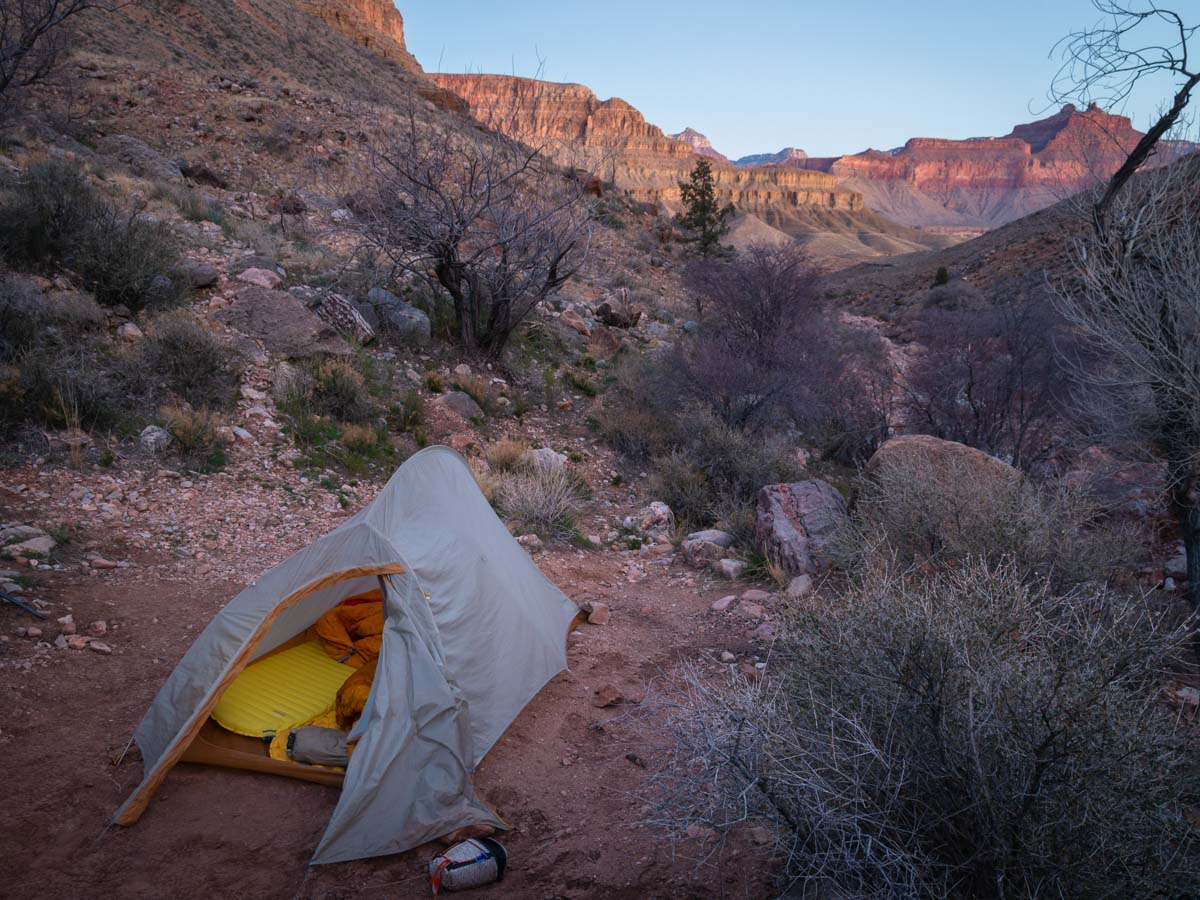
iRunFar’s Ben Kilbourne tests sleeping pads on a chilly morning in Colorado’s San Juan Mountains. Photo: iRunFar/Eszter Horanyi
For many fastpackers and ultralight backpackers who prioritize a light pack, choosing the best ultralight sleeping pad is a balancing act between weight, warmth, comfort, and durability. We do whatever it takes to carry the lightest, smallest item for each of our needs to minimize pack weight, but most of us still want a good night’s sleep.
Some of us forgo taking a proper sleeping pad when we’re trying to cover a lot of ground, but after many nights of shivering on bare ground, we don’t recommend this strategy, especially if you’re trying to get some sleep. Proper rest will go a long way toward making your fastpacking trip enjoyable, and a comfortable pad is potentially even more important than a warm sleeping bag to protect you from the cold ground.
After extensive testing of both inflatable and non-inflatable pads, our team has developed recommendations to help you navigate the market’s choices. We rate pads based on their durability, weight, packable size, and comfort, and we offer suggestions that strike the right balance among these criteria.
We found the Therm-a-Rest NeoAir XLite NXT Sleeping Pad to be a lightweight, durable inflatable pad that can withstand normal use without worrying about punctures. When it came to foam pads, the NEMO Switchback Ultralight Sleeping Pad proved to be our favorite. If we wanted the warmest pad that was still reasonably lightweight, we turned to the Therm-a-Rest NeoAir XTherm NXT Max Sleeping Pad. And, of course, we couldn’t help but include the Gossamer Gear Thinlight Foam Pad 1/8″ for the true minimalists who are going to be tired enough at the end of the day that they could sleep in a pile of rocks.
Below are our top picks for fastpacking sleeping pads, ranging from thin pieces of foam to thick, warm inflatable pads. For more background information, see our buying advice, testing methodology, and frequently asked questions below the picks.
You can find a compilation of all of our other favorite fastpacking gear in our best ultralight backpacking gear guide. If you’re looking for something specific, check out our guides on the best fastpacking packs, best ultralight tents, and best ultralight sleeping bags.
Best Ultralight Sleeping Pads
- Best Inflatable Ultralight Sleeping Pad: Therm-a-Rest NeoAir XLite NXT Sleeping Pad
- Best Inflatable Ultralight Sleeping Pad — Runners-Up: Sea to Summit Ultralight Insulated Air Sleeping Pad, NEMO Tensor Trail Ultralight Insulated Sleeping Pad
- Best Foam Ultralight Sleeping Pad: NEMO Switchback Ultralight Sleeping Pad
- Lightest Foam Ultralight Sleeping Pad: Gossamer Gear Thinlight Foam Pad 1/8″
- Warmest Ultralight Sleeping Pad: Therm-a-Rest NeoAir XTherm NXT Max Sleeping Pad

iRunFar’s Meghan Hicks and Eszter Horanyi test sleeping pads and other fastpacking gear on the Wind River High Route in Wyoming. Photo: iRunFar/Eszter Horanyi
Best Inflatable Ultralight Sleeping Pad: Therm-a-Rest NeoAir XLite NXT Sleeping Pad ($200)
Pros:
- Very light and warm
- Comfortable
- Moderately durable 30-denier fabric
- Large and effective inflation bag
Cons:
- Expensive
- Mummy shape was tippy for some testers
- Loud, crinkly sound bothers some
The Therm-a-Rest NeoAir XLite NXT Sleeping Pad is a tried and true sleeping pad that many testers on the iRunFar team use as their go-to sleeping pad for nearly all of their fastpacking trips. It’s currently Therm-a-Rest’s lightest sleeping pad option, and we’ve found it it strikes the right balance between weight, warmth, and comfort for all but the coldest overnight trips. We appreciate its durability and don’t fret about puncturing it under normal circumstances. We’ve been using different versions of this sleeping pad for a decade, and we think its upgrades, like a large inflation bag and effective one-way valve, only makes it better.
This sleeping pad comes in four sizes: Regular Short, Regular, Regular Wide, and Large. The size regular, which is what we tested, has an actual weight of 13.2 ounces, excluding the stuff sack and inflation bag. It has a three-inch thickness and an R-value of 4.5, the second-highest of any pad on this list. iRunFar’s Editor-in-Chief, Meghan Hicks, uses this as her sleeping pad after years of not taking a sleeping pad along on fastpacking trips in her attempt to keep her pack as light as possible. She also carries an inflatable pillow these days, so perhaps her gram-counting tendencies are starting to get a little more relaxed.
The 30-denier fabric feels thin, but we haven’t had an excessive number of punctures over extensive use. We always put a ground cloth underneath our sleeping pads, but this one seems to have a lower-than-average puncture rate. Because it packs down to a 9 x 4.1 inch package, it’s easy to fit into a fastpack.
While Therm-a-Rest claims this pad is less crinkly than its predecessor, it’s still not the quietest on this list. The horizontal baffles are comfortable enough, and we’ve spent many long hours lying on the pad during fall trips when the days are short.
Due to its combination of R-value, small size, and relatively low weight, this is the best all-around sleeping pad for virtually any three-season fastpacking trip. While it’s on the more expensive side of sleeping pads, if you’re planning on spending a lot of nights out in a range of temperatures, this pad is worth the investment.
Read our full Therm-a-Rest NeoAir XLite Sleeping Pad review, to get a more in-depth feel for the previous version of this pad.
Type: Inflatable | Actual Weight: 13.2 ounces (374 grams) | R-value: 4.5 | Shape: Mummy | Thickness: 3 inches (7.6 centimeters) | Packed Size: 9 x 4.1 inches (23 x 10 centimeters)
Shop the Therm-a-Rest NeoAir XLite NXT Sleeping PadBest Inflatable Ultralight Sleeping Pad — Runner-Up: Sea to Summit Ultralight Insulated Air Sleeping Mat ($160)
Pros:
- Comfortable
- Inexpensive for an inflatable pad
- Warm
Cons:
- Heavier
The Sea to Summit Ultralight Insulated Air Sleeping Mat is an excellent option if you find sleeping on vertical or horizontal baffles less comfortable than quilted ones but still want a fairly light and durable sleeping pad. We found that the quilted baffle pattern did a better job cradling us, resulting in less shifting around during the night. While not the lightest pad on the market — in size regular, it weighs 19.3 ounces with the inflation bag and 17.9 ounces without — it’s still competitive and less expensive than other options. This pad comes in extra small, small, regular, and large sizes to accommodate various body types. You can opt for a shorter version if you use your pack under your legs for added insulation if you want to save a few grams.
It also has a relatively high R-value of 3.1, which makes it an excellent three-season pad. However, since it is heavier than pads with comparable R-values, it is challenging to choose this pad over its competitors when specifically considering warmth-to-weight ratios. But the quilted baffles justified the extra weight for at least one of our testers. When inflated, it seems impossibly thin and incapable of providing either comfort or warmth, but it does an admirable job at both.
We tested this pad both during overnight trips in the Wasatch Mountains, where temperatures dipped to 22 degrees Fahrenheit, and on several trips in the San Juan Mountains of Colorado, where temperatures hovered around freezing at night. We found that we stayed plenty warm, even with a lighter sleeping bag. If you’re looking to assemble an affordable fastpacking kit or want a slightly more comfortable sleeping experience, this is a great choice.
Type: Inflatable | Actual Weight: 17.9 ounces (506 grams) | R-value: 3.1 | Shape: Mummy | Thickness: 2 inches (5.1 centimeters) | Packed Size: 9 x 4 inches (23 x 10 centimeters)
Shop the Sea to Summit Ultralight Insulated Air Sleeping MatBest Inflatable Ultralight Sleeping Pad — Runner-Up: NEMO Tensor Trail Ultralight Insulated Sleeping Pad ($180)
- Great value
- Durable
Cons:
- Not exceptional in any one aspect, but strikes a good balance with everything
The NEMO Tensor Trail Ultralight Insulated Sleeping Pad isn’t the lightest, nor is it the warmest or the least expensive. Instead, it’s a great value in that it strikes a balance in all its features. At $180, with a weight of 16 ounces and an R-value of 2.8, it’s the mid-range of price, weight, and R-value. Sleeping pads are all about compromise, and this one is slightly more expensive than the Sea to Summit Ultralight Insulated Air Sleeping Mat, not quite as warm, but lighter.
What stood out to us about this pad was its durability. Made of 40-denier fabric underneath and 20-denier fabric on top, it is durable and can withstand more wear and tear than some of the lighter pads in this guide. The quilted baffle design makes this a very comfortable pad, and at 3.5 inches thick, it keeps you elevated off the ground. We appreciated, or perhaps our tentmates appreciated, that the material is quiet when we rolled around during the night. A metalized Thermal Mirror film in the baffles effectively reflects heat back toward the body, and while the 2.8 R-value limits this pad to warmer weather trips, it remains sufficiently warm, especially when paired with a warm sleeping bag.
This sleeping pad is available in a variety of lengths and widths, allowing you to select the one that best suits your body size and needs. It also comes in a rectangular cut, providing a little extra space to stretch out. NEMO also offers a lifetime guarantee on its products.
Type: Inflatable | Actual Weight: 16.1 ounces (456 grams) | R-value: 2.8 | Shape: Mummy | Thickness: 3.5 inches (8.9 centimeters) | Packed Size: 10 x 4 inches (25 x 9 centimeters)
Shop the NEMO Tensor Trail Ultralight Insulated Sleeping PadBest Foam Ultralight Sleeping Pad: NEMO Switchback Ultralight Sleeping Pad ($60)
- Very light
- Will never deflate
- Packs down smaller than other foam pads we tested
- Inexpensive
- Can trim it to save weight
Cons:
- Foam pads can be uncomfortable for some
- Doesn’t fit inside most packs
For several reasons, the NEMO Switchback Ultralight Sleeping Pad is our top choice for foam sleeping pads for fastpacking. Priced at $60, it costs significantly less than the inflatable pads on this list and is our top choice for a budget-friendly fastpacking pad. While we can argue that a foam pad will never be as comfortable or warm as an inflatable one, there’s a reason most thru-hikers opt for them for their long treks: They never go flat.
At 14.5 ounces, the Switchback is roughly the same weight as our top inflatable pick, the Therm-a-Rest NeoAir XLite NXT Sleeping Pad. Since it’s made of foam, it’ll never get punctured and go flat, meaning you don’t have to put a groundsheet or tent underneath it, another weight-saving feature. The peace of mind that a foam pad can provide over an inflatable is also worth considering when choosing between options. Plus, you can pull it out to sit on during a lunch stop or while eating dinner.
There’s no question that foam pads aren’t for everyone. One of our testers swore off foam years ago after several nights of bruised hips but gave it a try in the interest of this test. He is a finicky sleeper, though, and still can’t get used to it. Other testers have fewer issues with the firmness and sleep well on it.
One tester, who is a stomach sleeper, had no issues with the firmness, and another pointed out that any sort of pad is better than no pad at all.
We also like that we could use this pad as a frame sheet in some packs, making the pack more rigid and preventing sharp items from poking us in the back. For those who are especially weight conscious, you can cut this pad to shorter lengths and round out the shoulder, torso, or legs to fit your specific body outline and needs.
One downside to this pad — and all foam pads — is its bulkiness. With most fastpacking packs, you have to attach the pad to the back of the pack under a web of shock cords, where its bulkiness will make your pack look less sleek. The reality is that this only matters if aesthetics are important to you or if you spend a lot of time bushwhacking off trail.
These issues become less important, however, for fastpackers who prioritize reliability. This pad is light, comfortable enough for most of our testers, and inexpensive, making it the best foam sleeping pad for fastpacking that we’ve found.
Type: Foam | Actual Weight: 14.8 ounces (418 grams) | R-value: 2 | Shape: Rectangular | Thickness: 0.9 inches (2.3 centimeters) | Packed Size: 20 x 5 x 5.5 inches (51 x 13 x 14 centimeters)
Shop the NEMO Switchback Ultralight Sleeping PadLightest Foam Ultralight Sleeping Pad: Gossamer Gear Thinlight Foam Pad 1/8″ ($22)
- Extremely light
- Inexpensive
- Won’t spring leaks
Cons:
- Not very comfortable
- Not very warm
There is a specific type of trip where the Gossamer Gear Thinlight Foam Pad 1/8″ makes more sense than any other pad on this list. While most people would shy away from trying to sleep on a piece of foam that’s not much thicker than a quarter, if saving weight is a top priority, this pad provides a reasonable amount of insulation for how light it is. It’s not the most comfortable pad to lie on, but if you need to go as light as possible without sleeping directly on a ground sheet, this pad might be what you’re looking for. It’s more comfortable than a sheet of Reflectix, which is another option that the truly weight conscious occasionally turn to.
This pad weighs only 2.7 ounces, making it the lightest on our list. It also packs down surprisingly small and functions as a back pad in many fastpacking packs. At $22, it’s inexpensive too.
The main downside is that no one will ever describe this sleeping pad as comfortable. But it’s not meant to be. It’s intended to provide just a bit of extra padding and warmth to get you through the night. But with soft site selection, it can be a full step up from not carrying a pad at all. Two of our testers use trimmed-down versions for trips when they want low bulk and minimal weight, but they want some extra comfort while moving fast.
This is also an excellent choice for ambitious adventures when you’ll be tired enough to sleep wherever you happen to stop for the night and for self-supported stage races where you carry your kit as you race. Regardless, it is still far from comfortable and warm. We do not recommend this pad for colder excursions when thermal protection from the ground is necessary. But if you’re the type of person who really likes to put in those long days and is content to sleep anywhere your feet will deposit you, take a look at this pad.
Type: Foam | Actual Weight: 2.7 ounces (79 grams) | R-value: n/a | Shape: Rectangular | Thickness: 0.13 inches (0.3 centimeters) | Packed Size: 19 x 3 inches (48.3 x 7.6 centimeters)
Shop the Gossamer Gear Thinlight Foam Pad 1/8 InchWarmest Ultralight Sleeping Pad: Therm-a-Rest NeoAir XTherm NXT Max Sleeping Pad ($270)
Pros:
- Warmest pad we tested
- Durable
- Very comfortable
Cons:
- Expensive
- Heavy
Sometimes, warmth is the top priority when fastpacking or backpacking, and the Therm-a-Rest NeoAir XTherm NXT Max Sleeping Pad has an R-value of 7.3 that will protect you from the cold ground. We choose this pad for early-season fastpacking trips through the mountains, where we may have to sleep on snow or when nighttime lows could dip into the teens. It’s also our favorite pad for frigid winter fastpacking trips through the canyon country of the Colorado Plateau. Unfortunately, with this extra warmth comes extra weight.
At 22.3 ounces for size regular, this is the heaviest pad on this list, but it isn’t that large to pack, or even all that heavy, especially considering its warmth. In addition to its incredibly high R-value, the bottom is made of 70-denier material, enhancing its durability, while the top is constructed from 30-denier material to reduce weight and increase packability.
One of our female testers who sleeps cold prefers this pad over the Therm-a-Rest NeoAir XLite NXT Sleeping Pad because she’s willing to carry a bit of extra weight to stay warm at night. She and some of our other testers have also found rectangular pads such as this one to be more stable and, therefore, more comfortable than most mummy-shaped pads. If you are a cold sleeper and don’t want to feel the cold ground again, consider adding this to your fastpacking kit.
Type: Inflatable | Actual Weight: 22.3 ounces (633 grams) | R-value: 7.3 | Shape: Rectangular | Thickness: 3 inches (7.2 centimeters) | Packed Size: 11 x 5 inches (28 x 13 centimeters)
Shop the Therm-a-Rest NeoAir XTherm NXT Max Sleeping Pad
Comparing the Best Ultralight Sleeping Pads
| PAD | PRICE | WEIGHT | R-VALUE | PACKED SIZE |
| Therm-a-Rest NeoAir XLite NXT Sleeping Pad | $200 | 13.2 ounces | 4.5 | 9 x 4.1 inches |
| Sea to Summit Ultralight Insulated Air Sleeping Mat | $160 | 17.9 ounces | 3.1 | 9 x 4 inches |
| NEMO Tensor Trail Ultralight Insulated Sleeping Pad | $180 | 16.1 ounces | 2.8 | 10 x 4 inches |
| NEMO Switchback Ultralight Sleeping Pad | $60 | 14.8 ounces | 2 | 20 x 5 x 5.5 inches |
| Gossamer Gear Thinlight Foam Pad 1/8″ | $22 | 2.7 ounces | N/A | 19 x 3 inches |
| Therm-a-Rest NeoAir XTherm NXT Max Sleeping Pad | $270 | 22.3 ounces | 7.3 | 11 x 5 inches |
Buyer’s Guide: How to Choose the Best Ultralight Sleeping Pad for Fastpacking
When selecting the best ultralight sleeping pad for your specific needs, consider several key factors. For some people, weight is the top priority, allowing for fast and efficient movement at the expense of some comfort and warmth. For others, sleeping as well as possible is placed above saving a few ounces in a pack. Durability is also a key factor when comparing sleeping pads, especially for longer trips.

The Therm-a-Rest NeoAir XLite NXT Sleeping Pad has been a favorite of the iRunFar testing team for years. Photo: iRunFar/Eszter Horanyi
Weight
Because we’re looking for the best ultralight sleeping pad specifically for fastpacking, we wanted to ensure that any pad we chose would keep your pack light and runnable. While obtaining sleeping pads at significantly lower costs is possible, the additional weight adds up quickly as the price decreases.
The lightest pads are generally the least comfortable and have lower R-values. The Gossamer Gear Thinlight Foam Pad 1/8″, which really is just a very thin piece of insulating foam, is a prime example of a pad that isn’t all that comfortable or warm, but it’s light and actually offers a lot for what it is. Depending on the trip, that might be exactly what you want. Some of our testers also like to cut foldable foam pads into a mummy shape to shave a few grams. Others even like to cut foam pads, like the NEMO Switchback Ultralight Sleeping Pad, down to torso length and then place their pack under their legs for sleeping. Buying a shorter inflatable pad also accomplishes this.
If you’re looking to save weight but want an inflatable pad, the Therm-a-Rest NeoAir XLite NXT Sleeping Pad is the lightest pad we have included on our list. While lighter inflatable pads exist, we found that they did not meet our durability standards.
However, even if you plan to use the heaviest pad on this list, the Therm-a-Rest NeoAir XTherm NXT Max Sleeping Pad, you should still be able to run comfortably if you strategically plan the rest of your kit with no redundancy and individual items that have multiple uses for efficiency. So, if you prioritize comfort but still want a lightweight pack, you may have to spend a little more time fine tuning other aspects of your kit.
R-value
R-value is a measure of a material’s resistance to thermal conductivity. In other words, it’s a measure of a sleeping pad’s ability to prevent the loss of body heat to the cold ground, or, in simpler terms, its ability to keep you warm. The higher the R-value, the warmer the pad will be, and most three-season pads have an R-value in the three to four range.
Winter sleeping pads can have R-values of seven and up, including the very warm Therm-a-Rest NeoAir XTherm NXT Max Sleeping Pad. Additionally, R-values are additive, allowing you to combine sleeping pads for increased insulation. Some people choose to use both a foam and an inflatable pad for maximum warmth in icy conditions.
If your trips occur primarily in the warmer months, the best ultralight sleeping pad for you may have a lower R-value, as you won’t need much insulation. Lower R-value pads, especially uninsulated ones, tend to be significantly lighter than those meant for three-season conditions. The NEMO Switchback Ultralight Sleeping Pad, with its R-value of two, may perform fine for you if you sleep on soft ground in warm temperatures.
If you plan fastpacking trips in colder temperatures or where you may have to sleep on the snow, choose a pad with a higher R-value, such as the Therm-a-Rest NeoAir XLite NXT Sleeping Pad, which has an R-value of 4.5.

Using a bivy can protect your sleeping pad from punctures by rocks and other sharp objects. Photo: iRunFar/Eszter Horanyi
Inflatable Sleeping Pads
Inflatable sleeping pads are almost always more comfortable than foam pads, so we recommend them for fastpackers and ultralight backpackers who prioritize nighttime comfort. They also pack down much smaller than foam pads, keeping your pack streamlined and small. A pad like the Therm-a-Rest NeoAir XLite NXT Sleeping Pad is an excellent option for those seeking comfort while keeping their pack weight low.
The biggest downside to inflatable pads is that they can spring leaks. We recommend that inflatable pad users sleep in a bivy, a tent with a floor, or on a ground tarp, such as the window insulation plastic found at your local hardware store, to protect an inflatable pad from punctures. We also recommend brushing off the top of a pad before lying down for the night, as a surprising number of punctures come from the side you’re sleeping on. A leaking pad can be uncomfortable and dangerous if you are sleeping in cold temperatures.
Foam Sleeping Pads
Foam sleeping pads have the inherent benefit of being 100% puncture-proof, a valuable feature when choosing the best ultralight sleeping pad for trips in rocky or desert environments where much of the plant life seems weaponized and specifically designed to poke holes in thin inflatable sleeping pads. One of our testers lost her pad to a gust of wind and watched it land in a dead juniper tree, ripping open to the point that it was irreparable. The reliability of foam pads is one reason fastpackers and ultralight backpackers sometimes choose them over inflatable options.
Foam pads are also relatively inexpensive. For example, the NEMO Switchback Ultralight Sleeping Pad is $150 less than our top inflatable pad pick, the Therm-a-Rest NeoAir XLite NXT Sleeping Pad.
One big downside to a foam pad is its abysmal packability. Most fastpackers and ultralight backpackers must strap folding foam pads to the back of the pack, where they can get hung up on branches when bushwhacking. They are also generally significantly less comfortable but far better than nothing — and far better than a deflated inflatable pad with comes with some level of emotional distraughness as well.
Mummy Versus Rectangular Shape Sleeping Pads
Like many sleeping bags, many inflatable pads are rounded at the head and foot, creating a mummy shape. Rounding the corners saves a decent amount of weight, but it also significantly reduces the overall surface area of the pad. Even though a 72-inch long mummy-shaped pad and a 72-inch long rectangular pad are the same length if you measure right down the middle, the rectangular pad will feel much longer because you can sleep diagonally, utilizing the corners. Rectangular pads are also more comfortable for those with broader shoulders.
Some of our testers also find rectangular pads, such as the Therm-a-Rest NeoAir XTherm NXT Max Sleeping Pad, to be more stable than mummy-shaped pads, like the Sea to Summit Ultralight Insulated Air Sleeping Mat.

Different pad shapes and baffle patterns can be more or less comfortable for different types of sleepers and body shapes. Photo: iRunFar/Eszter Horanyi
Durability
Foam pads are inherently more durable than inflatable pads because they won’t spring leaks. However, they can get shredded when bushwhacking. Additionally, foam will eventually compress, becoming less comfortable and less insulating over time.
While inflatable pads can get holes, you can also patch them almost indefinitely, so if you take care of them, they can outlast foam pads. Inspect the thickness of an inflatable sleeping pad’s fabric to estimate its probable puncture resistance. Higher denier fabrics, such as those found on the Therm-a-Rest NeoAir XTherm NXT Max Sleeping Pad, are more puncture-resistant than lower denier ones.
The more significant longevity issue of inflatables is the durability of the insulation. Synthetic insulation, like that used in the Sea to Summit Ultralight Insulated Air Sleeping Mat, can compress over time and become less effective. We recommend that you prevent moisture from entering the inside of your sleeping pad by inflating it with an inflation bag or electric pump instead of your breath and then storing it uncompressed with the valve open. Using an inflation bag can also reduce the chances of microbes growing inside your sleeping pad.
Baffles are another point of failure for inflatable pads. Over time, internal welds can begin to fail, and the pad may bubble, but we’ve found that companies are generally happy to warranty pads if this happens. We didn’t have this issue arise with any of the pads included in this guide.
Comfort
When choosing the best ultralight sleeping pad, comfort is subjective, and some fastpackers are moving too quickly to prioritize it anyway. However, for many of us, sleeping pad comfort is critical because we need a good night’s rest to feel good cranking out miles the following day.
If that’s you, opt for an inflatable pad instead of a foam pad. Our testers all agree that inflatable pads are more comfortable. Some of us have also found rectangular pads to be more stable and comfortable than mummy-shaped pads. Quilted pads, like the Sea to Summit Ultralight Insulated Air Sleeping Mat, tend to be cozier than pads with vertical or horizontal baffles, like the Therm-a-Rest NeoAir XLite NXT Sleeping Pad.

Above are some of the sleeping pads we tested for size comparison. From left to right are the Therm-a-Rest NeoAir XLite Sleeping Pad, Therm-a-Rest NeoAir UberLite Sleeping Pad, NEMO Switchback Ultralight Sleeping Pad, Gossamer Gear Thinlight Foam Pad 1/8″, Sea to Summit Ether Light XT Air Sleeping Mat, Therm-a-Rest NeoAir XTherm Max Sleeping Pad, and Sea to Summit Ultralight Insulated Air Sleeping Mat. Photo: iRunFar/Ben Kilbourne
Packed Size
Fastpacking packs are usually low-volume — often between 20 and 30 liters — so we recommend choosing a pad that compresses down small, such as the Therm-a-Rest NeoAir XLite NXT Sleeping Pad, which rolls up to 9 by 4.1 inches. The best ultralight sleeping pads will take up minimal space in your pack. If you want to explore your options for a fastpacking pack, take a look at our Best Fastpacking Packs guide.
The rest of the inflatable pads included in this guide pack to about the same size, while the pad with the largest packed size on our list is the somewhat unwieldy NEMO Switchback Ultralight Sleeping Pad, which measures 20 x 5 x 5.5 inches. Most users must strap this pad to the outside of their pack, either on top or at the back.

Above are some of the sleeping pads we tested, packed for size comparisons. From left to right are the Therm-a-Rest NeoAir XLite Sleeping Pad, Therm-a-Rest NeoAir UberLite Sleeping Pad, NEMO Switchback Ultralight Sleeping Pad, Gossamer Gear Thinlight Foam Pad 1/8″, Sea to Summit Ether Light XT Air Sleeping Mat, Therm-a-Rest NeoAir XTherm Max Sleeping Pad, and Sea to Summit Ultralight Insulated Air Sleeping Mat. Photo: iRunFar/Ben Kilbourne
Why You Should Trust Us
The iRunFar team has been fastpacking for over a decade, and we have watched this adventure niche grow. What started as two separate endeavors — ultralight backpacking and adventure running — have now merged into one: fastpacking. One critical piece of fastpacking equipment is your sleeping pad, so we’ve recommended six that will keep you warm — and sometimes even comfortable — on just about any fastpacking trip.
Members of the iRunFar team have been using several of the sleeping pads on this list for years, and we’ve added others to this list of favorites through a research and testing process that started in 2022.
For the initial version of this guide, we looked far and wide to find all the sleeping pads on the market that were light and small enough to qualify as fastpacking pads. Then we tested 14 of them on adventures in places like the Wasatch Mountains of northern Utah, the Tavaputs Plateau of eastern Utah, Capitol Reef National Park in Utah, the San Juan Mountains surrounding Silverton, Colorado, and several wilderness areas around the American West. The pads were used by multiple people in several different environments and evaluated on their durability, comfort, warmth, and packability.
We keep this guide updated by continually testing new sleeping pads as they become available on the market. Our team also continues to use the pads included in this guide because, in the end, they are our favorites. Ongoing testing allows us to speak about any durability issues that we encounter with products.
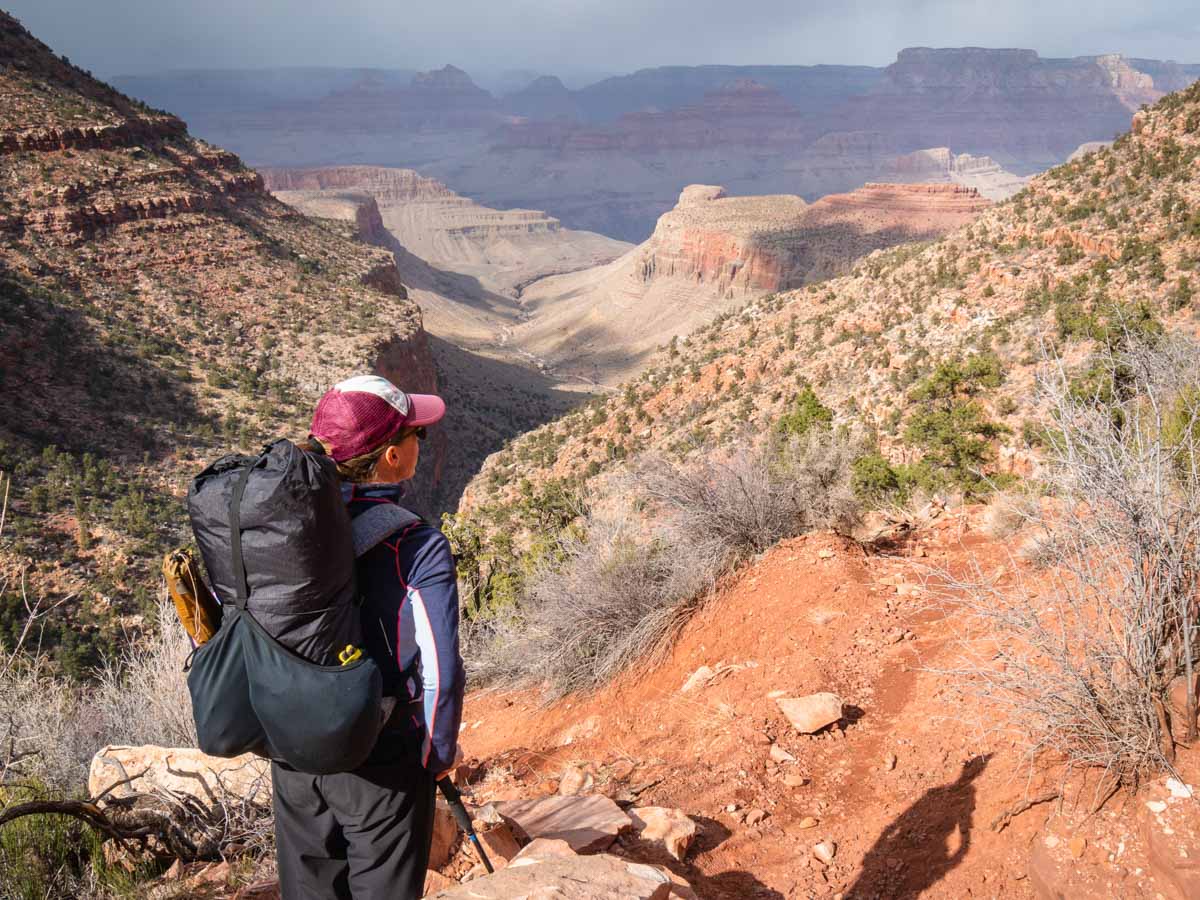
iRunFar’s Meghan Hicks descending into the Grand Canyon on a five-day fastpacking trip. Photo: iRunFar/Eszter Horanyi
Frequently Asked Questions About the Best Ultralight Sleeping Pads for Fastpacking
What is fastpacking?
Fastpacking combines two sports — ultralight backpacking and adventure running — to create a single activity. Want to explore that cool backcountry basin you’ve been eyeing but only have a few days free on your schedule? Fastpacking. Have back-to-back long runs on your schedule and don’t want to return to your car or house in between? Fastpacking.
Fastpacking isn’t just running; it isn’t just hiking. In the ideal world, you take the minimum equipment to safely spend the night somewhere and then go. Run a bit, hike a bit, stop to make coffee or fly fish, and then run and hike again. While calling your movement running can be a bit of a misnomer when you’ve got 10 to 15 pounds on your shoulders on rough terrain, hopefully, you pack light enough to cover miles quickly and relatively unencumbered, and you can jog flats and downhills. A lightweight inflatable pad like the Therm-a-Rest NeoAir XLite NXT Sleeping Pad can make a big difference in your ability to run during a fastpacking trip.
If you’re looking for other pieces of fastpacking gear, you can check out our Best Ultralight Backpacking Gear guide.
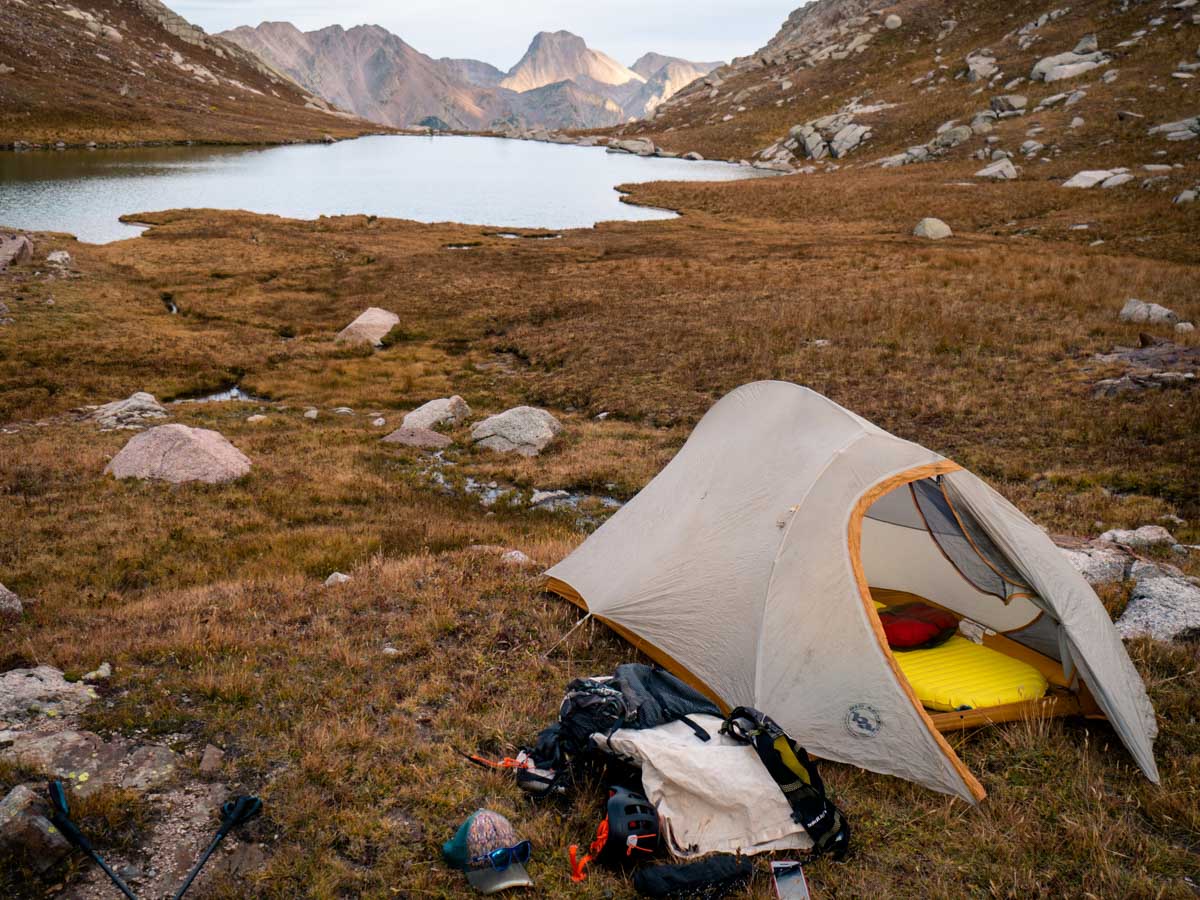
A light sleeping pad can keep your pack weight low and let you cover a lot of distance and camp in beautiful places. Photo: iRunFar/Eszter Horanyi
Do I need to use a sleeping pad at all?
This will depend on the expected temperatures during your trip and your ability or inability to sleep well on hard, cold surfaces. If it is warm out — temperatures greater than 50 degrees Fahrenheit at night — you may be able to skip a pad altogether. A few on our testing team do just that, sleeping on their pack and rain jacket because they won’t need much insulation to fall asleep after a big day out.
This works best if you can find dry and soft surfaces, such as meadows, pine needles, or sand, to sleep on. It also helps if you’re completely exhausted at the end of the day. Still, even on the warmest nights, you might appreciate a little insulation from a minimalist pad like the Gossamer Gear Thinlight Foam Pad 1/8″.
How important is my sleeping pad in the context of fastpacking?
If temperatures are below 50 degrees Fahrenheit at night, we recommend carrying a sleeping pad to insulate your body from the cold ground. We understand how annoying it is to carry a pad when you’re trying to move fast, but at a minimum, we recommend something such as the Gossamer Gear Thinlight Foam Pad 1/8″. It’s not terribly comfortable, but it will provide enough insulation to get you through the night.
If you sleep cold or prioritize sleeping comfort over carrying a few extra ounces, you may want to step up to an inflatable pad such as our top pick, the Therm-a-Rest NeoAir XLite NXT Sleeping Pad. This pad has the benefit of being very small when packed, but some fastpackers and ultralight backpackers still consider it, at nearly a pound, to be heavy.
Still, most of us prioritize fun and joy (and sleep) over pure speed during a trip and are willing to carry an actual sleeping pad. Most of our testers prefer inflatable pads for most trips and find the weight worth a good night’s rest.

Keeping dog paws off inflatable sleeping pads can keep them from springing leaks. Photo: iRunFar/Eszter Horanyi
Should I opt for an inflatable sleeping pad over a foam one?
The most compelling reasons to choose foam pads are their low cost, weight, and durability. The Gossamer Gear Thinlight Foam Pad 1/8″ is the cheapest and lightest pad on this list at $22 and 2.7 ounces. Even the NEMO Switchback Ultralight Sleeping Pad is only $55 and nearly as light as our best all-around sleeping pad, the Therm-a-Rest NeoAir XLite NXT Sleeping Pad.
One of the main reasons not to choose foam pads is that they are uncomfortable at worst or an acquired taste at best. They are also significantly less warm than most insulated inflatable pads, and we do not recommend them for fastpacking adventures in colder weather.
If your trips take you to high altitudes in the shoulder season when thermal protection is necessary, you’ll want to bring a warm, inflatable sleeping pad such as the Therm-a-Rest NeoAir XLite NXT Sleeping Pad. This pad is light, warm, comfortable, and packs down small. The most significant downsides to inflatable pads are their high cost and susceptibility to punctures. So, if you want to be comfortable and warm, can afford the higher price of an inflatable pad, and take care to avoid holes by consistently placing a groundsheet under your pad, don’t hesitate to choose an inflatable for fastpacking.
My inflatable sleeping pad keeps leaking. What do I do?
To find a suspected leak in your sleeping pad, inflate the pad about halfway, fold it in thirds, submerge it in a lake or bathtub, and look and listen for bubbles. You may need to kneel or press down on it with both hands to make it bubble. When you find the hole, mark it immediately with a Sharpie or any other tool you may have. Spraying soapy water onto an inflated pad can also reveal holes if you don’t have a body of water to submerge it in. This method makes it so you don’t have to fully soak your sleeping pad.
After letting the pad dry, apply the patch that came with it. All inflatable sleeping pads included in this guide come with a repair kit. You can also use a stick-on patch such as Tear-Aid Type A or a glue such as Aquaseal +FD or Aquaseal +UV.
We recommend Aquaseal +FD for home repairs because it tends to be more permanent and durable than stick-on patches. However, it takes eight to 12 hours to cure. Aquaseal +UV is better for field repairs because it cures in only 30 seconds in direct sunlight. The good news is that you can almost always successfully fix holes, whether in the field or at home, so taking the time to do so will keep your pad working for years.
While there are lighter pads available on the market than the ones listed in this guide, we found that they didn’t meet our minimum durability standards and were too prone to punctures for comfort. The Therm-a-Rest NeoAir XLite NXT Sleeping Pad is the lightest inflatable pad that we found that held up to regular use without springing leaks.

Many iRunFar team members use the Therm-a-Rest NeoAir XLite NXT Sleeping Pad as their go-to pad for fastpacking trips. Photo: iRunFar/Eszter Horanyi
Can I trim my foam sleeping pad to make it lighter and smaller?
Several of our testers have trimmed the Gossamer Gear Thinlight Foam Pad 1/8″ down to a piece large enough for only shoulders and hips to save weight. The result is a 1.2-ounce pad. The NEMO Switchback Ultralight Sleeping Pad is also trimmable. Each of the 14 sections weighs one ounce, so if you trim it down to only eight sections, it will weigh about eight ounces — about the right size for most folks’ shoulders and hips. Rounding the corners on foam pads will save even more weight.
Do I sleep with my sleeping pad inside or outside my sleeping bag?
Because companies design sleeping pads to insulate you from the ground and sleeping bags were made to surround your body snugly for efficient insulation, putting a bulky pad inside your sleeping bag can inhibit the intended function of both pieces of equipment. Most of the pads on our list — especially the thicker inflatables — take up a lot of space, reduce the comfort and insulating properties of your sleeping bag, and are better suited for use outside of a sleeping bag
Foam pads — especially those cut down to only shoulders and hips — are the exception to the rule. Placing a small, trimmed foam pad inside your sleeping bag ensures it stays in the right place under the hips and shoulders. And when you’re cowboy camping without a tent, you may want to place your trimmed foam pad inside your bag to keep it from flying away in the wind when you roll over at night.
I am always cold when I sleep. What’s the best sleeping pad for me?
If you are always cold at night, choose a pad with a high R-value, such as our top pick for warmth, the Therm-a-Rest NeoAir XTherm NXT Max Sleeping Pad, which has an R-value of 7.3. This pad is a little heavy at 22.3 ounces, so you may want to spend a bit extra time reducing the weight of your pack in other ways if you want to carry this pad but still want your pack to be runnable.
That said, the second-warmest pad on our list, the Therm-a-Rest NeoAir XLite NXT Sleeping Pad, has an R-value of 4.5 and weighs only 13.2 ounces.

An insulated sleeping pad can make fastpacking in cold weather much more enjoyable. Photo: iRunFar/Eszter Horanyi
My sleep pad’s inflation bag is heavy. Do I need to carry it?
No, and yes. Carrying an inflatable pad’s inflation bag is not mandatory because you can blow up any of the pads on our list with your breath. It’s tempting to leave it behind because it seems like unnecessary weight, weighing as much as three ounces in some cases.
That said, blowing up your pad with your mouth will introduce moisture into the pad, degrading the insulation and reducing its overall warmth over time. It can also lead to microbial growth inside your pad, which isn’t a health hazard but can look, for lack of a more eloquent word, gross. We recommend that you take the inflation bag along and find an additional use for it so it doesn’t feel like an unnecessary weight. We sometimes like to use an inflation bag stuffed with clothes as our pillow. The Therm-a-Rest NeoAir XLite NXT Sleeping Pad inflation bag is large enough to be a pack liner in smaller fastpacking packs.
Of course, if you’re trying to save weight on a fastpacking trip, you might want to tough it out with the Gossamer Gear Thinlight Foam Pad 1/8″ and not even worry about whether you need an inflation bag.
How light must my pad be to run with it in my pack?
Fastpackers are notorious gram-counters who occasionally go to great lengths to reduce their pack weight, like not carrying a sleeping pad at all. While we don’t recommend that course of action, the lighter your pack, the better. Most of our testers have found that pads in the 16-ounce range are light enough for running if you optimize everything else in your kit for low weight.
For instance, the warmer a pad is, the lighter your sleeping bag can be. In fact, a warm pad will pair well with a bottomless or quilt-style sleeping bag, which has little to no insulation under the body. You can learn more about different types of sleeping bags in our Best Ultralight Sleeping Bags guide. If you want to carry the extremely warm Therm-a-Rest NeoAir XTherm NXT Max Sleeping Pad, you’ll want to ensure that all other parts of your fastpacking kit are as light as possible.
How durable are inflatable pads?
Some of our testers have had sleeping pads made of 70-denier material last for 10 years, while others have gotten holes in those same pads in a matter of days. If you know you are hard on gear or will be camping on rough and jagged surfaces, choose a thicker, heavier inflatable pad.
Also, be sure to use a bivy, a groundsheet, or a tent with a floor to prevent holes. You can explore different options for shelters in our Best Ultralight Tents guide. It’s also a good idea to brush debris off your clothing and sleeping bag before lying down because, in our experience, and quite surprisingly, many pad holes happen on the top of the pad. If you’re worried about a pad springing a leak in the middle of a trip, you might just want to go with a foam pad like the NEMO Switchback Ultralight Sleeping Pad.
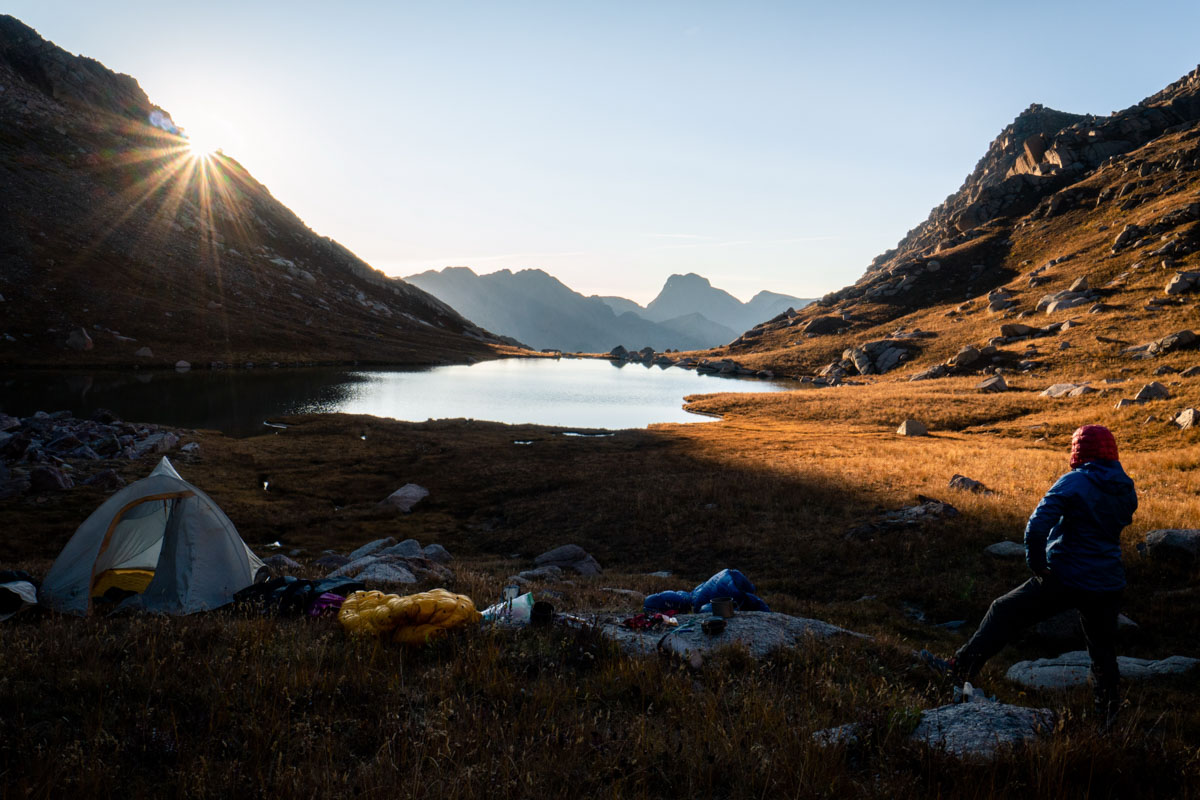
iRunFar’s Meghan Hicks contemplates a high camp during a fastpacking trip in the Colorado San Juan Mountains. Photo: iRunFar/Eszter Horanyi
How do I protect my inflatable sleeping pad during a fastpacking trip?
A leak in a sleeping pad during a trip can make for some miserable and potentially dangerous nights in the wilderness. To protect your inflatable pad during a trip, you’ll want to always use it either in a tent or on a ground cloth. Many shelter options in our Best Ultralight Tents guide feature a solid floor that protects your sleeping pad from the ground. Taking a few minutes to clear debris away from the area you’re sleeping can also help prevent punctures.
The pads on this list, even the very light ones like the Therm-a-Rest NeoAir XLite NXT Sleeping Pad, have proven to be durable and reliable as long as they are properly cared for.
Call for Comments
- Do you sleep better on foam or inflatable pads?
- How have you modified your foam sleeping pad to optimize for low weight?
- Have you ever gone without a sleeping pad altogether?

